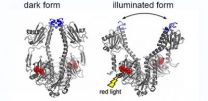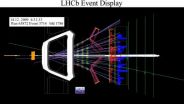(Press-News.org) The research groups of Janne Ihalainen (University of Jyväskylä) and Sebastian Westenhoff (University of Gothenburg) have clarified how the atom structure of bacterial red light photosensors changes when sensing light. The research reveals structural changes in phytochrome protein when illuminated.
"The results are a unique demonstration of proteins' ability to structural changes in different phases of their operation. This helps to understand how the biological photosensors function. The modelling and utilisation of protein for other applications becomes much easier when the protein structures, their changes and the speed of change are known," says Professor Ihalainen.
The function of few biological photosensors are already utilised in other fields of science, especially in neurosciences. By utilising reactions that are controlled by light, it is possible to achieve new breakthroughs in the cell biological research and, for example, in medical applications such as in phototherapy and in molecular diagnostics.
Organisms use photosensor proteins to sense light on different wavelengths. For example, mammals have rhodopsin proteins in their eyes. Phytochromes, one of the photosensor proteins of plants, fungi and bacteria, are sensitive to red light. The function of these photosensors was known already in 1970s and 1980s, but their molecular-level operating mechanisms are still unknown.
A pioneering research method
Time-resolved wide-angle X-ray scattering was used to study structural changes of this rather large protein complex in a solution form. The technique, TR-WAXS, is relatively new and in this study a successful combination of the experimental data with the molecular dynamic simulations enabled to track the detailed structural changes of the protein.
"We hope that other groups using TR-WAXS would test similar data-analysis method as well." Ihalainen says.
The light sensitive phytochrome structures were clarified both in a crystal form and in a solution. From the crystal structures, it is possible to see that small movement of individual atoms (scale of 0.1 – 0.2 nm) caused by the absorption of light is amplified to large structural changes (3 nanometres) in the whole protein complex. This amplification mechanism enables the light induced signal transmission from one protein to another very quickly and with precise replication accuracy. In turn, this signal transmission process initiates cellular-level changes in the organism.
INFORMATION:
The project "New strategies for detection conformational changes of proteins in real time" is funded by the Academy of Finland.
An article about the research was published in Nature: http://dx.doi.org/10.1038/nature13310
Further information:
Professor Janne Ihalainen, University of Jyväskylä
janne.ihalainen@jyu.fi, +358 400 247 979
Image 1: A familiar phenomenon: plants turn toward light. Plants sense light with their photosensors, from which phytochromes are the proteins to sense red light.
Image 2: The crystal structure of bacterial phytochrome changes when illuminated.
New atom-scale knowledge on the function of biological photosensors
2014-05-02
ELSE PRESS RELEASES FROM THIS DATE:
Small variations in genetic code can team up to have a bi
2014-05-02
Scientists at USC have definitively demonstrated that large sets of variations in the genetic code that do not individually appear to have much effect can collectively produce significant changes in an organism's physical characteristics.
Studying the budding yeast Saccharomyces cerevisiae, USC's Matthew B. Taylor and Ian M. Ehrenreich found that the effects of these genetic variants can depend on four or more other variants in an individual's genome.
Most genetic analyses of heritable physical characteristics, including genome-wide association studies in human populations, ...
New myeloma-obesity research shows drugs can team with body's defenses
2014-05-02
Obesity increases the risk of myeloma, a cancer of plasma cells that accumulate inside the bones.
And with current obesity trends in the United States and especially in South Texas, that's ominous.
"I'm predicting an increase in multiple myeloma," said Edward Medina, M.D., Ph.D., "and with the obesity problems we see in the Hispanic population, there could be a serious health disparity on the horizon."
Dr. Medina, a hematopathologist and assistant professor in the Department of Pathology at The University of Texas Health Science Center at San Antonio, is looking ...
AGA unveils latest advances in GI research at DDW 2014
2014-05-02
Chicago, IL (May 2, 2014) — International leaders in the fields of gastroenterology and hepatology will gather together for Digestive Disease Week® (DDW) 2014, the largest and most prestigious gastroenterology meeting, from May 3 to 6, 2014, at McCormick Place in Chicago, IL. DDW is jointly sponsored by the American Gastroenterological Association (AGA) Institute, the American Association for the Study of Liver Diseases (AASLD), the American Society for Gastrointestinal Endoscopy (ASGE) and the Society for Surgery of the Alimentary Tract (SSAT).
AGA researchers will present ...
Nature's chemical diversity reflected in Swedish lakes
2014-05-02
It's not only the biology of lakes that varies with the climate and other environmental factors, it's also their chemistry. More knowledge about this is needed to understand the ecology of lakes and their role in the carbon cycle and the climate. Today an international research group led by Uppsala University is publishing a comprehensive study of the composition of organic compounds in the prestigious journal Nature Communications.
- Lake water is like a very thin broth with several thousand ingredients in the recipe, all with different properties. At the same time ...
Stimulated mutual annihilation
2014-05-01
Twenty years ago, Philip Platzman and Allen Mills, Jr. at Bell Laboratories proposed that a gamma-ray laser could be made from a Bose-Einstein condensate (BEC) of positronium, the simplest atom made of both matter and antimatter (1). That was a year before a BEC of any kind of atom was available in any laboratory. Today, BECs have been made of 13 different elements, four of which are available in laboratories of the Joint Quantum Institute (JQI) (2), and JQI theorists have turned their attention to prospects for a positronium gamma-ray laser.
In a study published ...
Syracuse University physicists confirm existence of new type of meson
2014-05-01
Physicists in the College of Arts and Sciences at Syracuse University have made several important discoveries regarding the basic structure of mesons—subatomic particles long thought to be composed of one quark and one antiquark and bound together by a strong interaction.
Recently, Professor Tomasz Skwarnicki and a team of researchers proved the existence of a meson named Z(4430), with two quarks and two antiquarks, using data from the Large Hadron Collidor beauty (LHCb) Collaboration at CERN in Geneva, Switzerland. This tetraquark state was first discovered in Japan ...
Investigators find something fishy with classical evidence for dietary fish recommendation
2014-05-01
Philadelphia, PA, May 1, 2014 – Oily fish are currently recommended as part of a heart healthy diet. This guideline is partially based on the landmark 1970s study from Bang and Dyerberg that connected the low incidence of coronary artery disease (CAD) among the Eskimos of Greenland to their diet, rich in whale and seal blubber. Now, researchers have found that Eskimos actually suffered from CAD at the same rate as their Caucasian counterparts, meaning there is insufficient evidence to back Bang and Dyerberg's claims. Their findings are published in the Canadian Journal ...
Atypical form of Alzheimer's disease may be present in a more widespread number of patients
2014-05-01
JACKSONVILLE, Fla. — Neuroscientists at Mayo Clinic in Florida have defined a subtype of Alzheimer's disease (AD) that they say is neither well recognized nor treated appropriately.
The variant, called hippocampal sparing AD, made up 11 percent of the 1,821 AD-confirmed brains examined by Mayo Clinic researchers — suggesting this subtype is relatively widespread in the general population. The Alzheimer's Association estimates that 5.2 million Americans are living with AD. And with nearly half of hippocampal sparing AD patients being misdiagnosed, this could mean that ...
JCI online ahead of print table of contents for May 1, 2014
2014-05-01
Balancing protein turnover in the heart
Alterations in the ubiquitin proteasome system (UPS), which tags proteins for degradation, underlies some cardiomyopathies and age-related cardiac dysfunction. In the heart, the UPS is essential for the precise balance between cardiomyocyte atrophy and hypertrophy. In skeletal muscle, the E3 ubiquitin ligase atrogin-1 promotes atrophy by targeting hypertrophy-associated proteins for degradation; however, a role for atrogin-1 in cardiac proteostasis is not clear. In this issue of the Journal of Clinical Investigation, Marco Sandri, ...
Undersea warfare: Viruses hijack deep-sea bacteria at hydrothermal vents
2014-05-01
More than a mile beneath the ocean's surface, as dark clouds of mineral-rich water billow from seafloor hot springs called hydrothermal vents, unseen armies of viruses and bacteria wage war.
Like pirates boarding a treasure-laden ship, the viruses infect bacterial cells to get the loot: tiny globules of elemental sulfur stored inside the bacterial cells.
Instead of absconding with their prize, the viruses force the bacteria to burn their valuable sulfur reserves, then use the unleashed energy to replicate.
"Our findings suggest that viruses in the dark oceans indirectly ...




